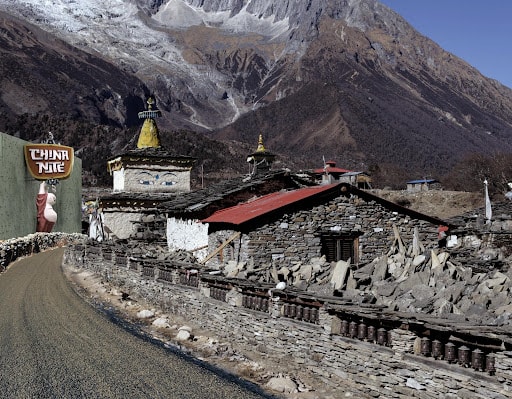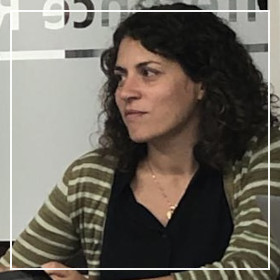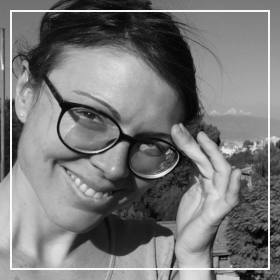It was already dark when I entered the small shop in the informal camp in rural Lebanon, where Khulud was waiting for customers. This was my first return to the field after more than a year of absence, and it was emotionally overwhelming. Khulud smiled and kissed me several times on the cheeks. I was visiting her together with her son, Abu Younes, who sat next to me while Khulud arranged food for us. I was surprised by her invitation to eat, a practice of hospitality I had only encountered at the beginning of my stay with the community when I was undoubtedly considered a foreign guest, a social standing I had thought altered by all my shared moments with Khulud.
That I wasn’t the only one thinking this way was confirmed a little later. I was still eating when Abu Younes lit up a cigarette, a gesture to which Khulud reacted by whispering something in his ear. His irritated gaze reached her as he spoke: “She is family!” I looked to Abu Younes for an explanation. He said that Khulud was upset that he had stopped eating before me, the guest. She lamented his refusal to perform one of the duties of hospitality. But Abu Younes interpreted his own gesture not as a refusal of tradition but of her imposition of the host/guest framework. For him, I was not a guest because of my social and political role within the community. My presence in the family’s everyday life was combined with my work at the informal school the community had created where I had helped plan the artistic programme, as well as draft and translate reports for international organisations and statements to Lebanese religious authorities regarding the hardships faced by displaced Syrians. My role was constantly renegotiated: sometimes, I was washing the dishes with Khulud’s daughter-in-law, and at other times I was sipping coffee with Abu Younes and other Syrian elders to discuss the situation in Syria, the challenges of their displacement in Lebanon, their engagement with Lebanese authorities, and social relations with the broader Syrian exile community. My role in family life sealed a level of trust and care that went beyond political work, yet it also made possible the role I performed within the school.
This reflection from Veronica Ferreri’s fieldwork is, in some ways, a story shared by many ethnographers. We come to the field and over time develop intense and shifting relationships with a range of people. We are drawn, by choice and by necessity, into the lives and projects of our interlocutors, all the more so when we have certain technical competencies that can work to the advantage of those we work with, or when we have explicit political commitments to our interlocutors. Veronica’s collaborations were organic, ad-hoc, programmatic in the flow of ordinary life, or else reactive, responding to events, like the rumours of possible camp raids and evictions, as well as the closure of Syrian informal schools.
We are drawn, by choice and by necessity, into the lives and projects of our interlocutors.
In the text that follows, co-authored by Veronica with Fuad Musallam, Ella Parry-Davies and Nadine Plachta, we bring this sense of ethnographic collaboration – forged in the crucible of familial, social, and political commitment – in conversation with the other three authors’ collaborations: a participatory archive in Lebanon, a set of collaborative soundwalks in London, a work of speculative photography in Nepal. These collaborations are multimodal, participatory, and co-constituted, and they are explicit attempts to produce specific things that can then have political effects for collaborators. They occur alongside, sometimes as part of, discrete political engagements, whose ambiguities are also central to the development of relations that feed into the political and creative work carried out by the communities and ourselves as researchers. Across them, we explore how similar re/negotiations are practised wherever collaboration is central to ethnographic work. In particular, we attend to the material conditions of collaboration – spatial, social, temporal and political – and how these shape and constrain the modes of engagement that take form. The following three reflections are on more time-bound collaborative projects, but framed by the opening vignette, they show how collaborative dynamics are informed by and also bleed into the “everyday” of ethnographic relationships. The reflections develop in open-ended ways, through the ebb and flow of the negotiation of roles, positions and modes of action, which have material contexts and conditions. This ebb and flow can even exceed what we think of as a discrete collaborative project and its intentions.
Materiality and tangibility
If Veronica’s leaving the field shifted her position within Khulud’s family, it was Fuad’s return to the Beirut-based Migrant Community Centre (MCC) that made an archival collaboration there possible. In fact, in the years between first spending time at the MCC in 2013-14 and returning in 2018, almost all those members Fuad had developed friendships with had left: deported, or granted asylum elsewhere, or no longer living near enough to the Centre, or simply moved away from the Centre’s activities. Nevertheless, his recollections of the Centre as a hub of activity (a yearly calendar of marches, demonstrations and celebrations, a weekly calendar of meetings, classes, services, and leisure, and the daily experience of a site thick with photos on every wall) informed the initial idea of a participatory archive of the Centre, curated and organised with members. In the context of a high turnover in membership and an always precarious existence, long-time members participating in the collaboration then pushed to find ways to teach newcomers what the Centre had achieved and commemorate the legacy of those people who helped it do so, especially those no longer present.
If the high turnover and uncertain situation motivated the collaboration, then material conditions contoured the actual form it took: two changes of location in six years, a space too small and constantly in use for different activities, things moving and being moved. Between changes of building, lack of storage, and the physical space in constant use, whole years of time were (materially) unaccounted for. Archivable material was found tucked away in children’s colouring books, or in drawers where it had been tidied away in haste when a room was needed for some other activity. MCC members involved in the archiving project tried to find times when one room or another was free to hold archiving sessions, but for month-long periods rooms were fully booked, often to create new things like posters and placards for demonstrations, but so too for the language classes, members’ meetings, or medical check-ups that made up the weekly and yearly political calendar of migrant community organising.
All these material aspects constrained what was found, who was involved, and where collaboration took place.
All these material aspects constrained what was found, who was involved, and where collaboration took place. But the best parts of the collaboration also emerged from those conditions. Collaborators responded to what they found: a history of the MCC became a visual primer of MCC’s activities, its form a response to the Centre’s polyglossia and the resonance of photos as a record of the collective past. Meanwhile, the idea to exhibit placards and posters in the Centre was wholly serendipitous, a product of members in one archiving session suggesting something be put up in the room where the session took place. In a context where the possibility of migrant worker cross-community organising was a precarious achievement, the collaboration created tangible things: the protest paraphernalia up on the wall, the poster formatted and ready to print, the archive safely stored, accompanied with resources for how to use it. Material constraints were also sites of possibility, then. But the collaboration was, importantly, only ever one (small) part of the MCC as a space, and the lives and activities of members, even those actively collaborating. This should give pause for thought to consider the way that a collaboration relates to its object, and the social and political relations in which it is embedded.
The materiality of time
The noisy and stuff-filled life of Sundays at MCC belied silent weekdays when its members were at work elsewhere. Here wage labour shapes the time and space where collaboration can occur, pointing to temporality itself as a material concern. The question is acute when the community of collaboration is defined by their category of labour, and face severe forms of exploitation and oppression. This was the case for many MCC members who were subject to structural violence tied to misogyny, racism, and precarious migration status. Ella’s research involved making collaborative soundwalks with migrant domestic workers in Lebanon and in the UK. The soundwalks attempted to generate a mode of listening attentive to participants’ experiences and their decisions about self-representation. Soundwalk-making involves going for a walk and recording a conversation in a place a domestic worker has chosen for its significance, often a site of activism (either quotidian or organised). The recording is then co-edited with the collaborator, and the finished soundwalk is uploaded to the project website along with instructions and a map, so that listeners can return to the place in question, playing the edited soundwalk through headphones as they re-trace the initial walk.
The collaborative intentions of the project were at times compromised by the realities of precarity, unpredictability and transience.
While the finished soundwalks were between two and twenty-five minutes each, participants spent up to thirteen hours editing them. Making sure they would be remunerated for this time involved negotiations concerning research ethics, where the importance of non-coercion, and the principle that the collaboration involved more than a financial transaction, had to be balanced against recognition of their creative labour. Audio editing is extremely labour-intensive, and the collaborative intentions of the project were at times compromised by the realities of precarity, unpredictability and transience. If domestic workers’ employers had unexpected guests, a day off would be retracted at the last minute, without pay. If their migratory status came under review, concerns about visibility and deportation might make somebody withdraw from the project entirely. Attending to these limitations recognises the uneven efforts of different bodies in collaboration and considers creative agency and labour as two sides of the same coin.

Collaboration, anticipation, and their limits
Each soundwalk expresses just a fragment of a person’s narrative. As listeners, it asks us to acknowledge the limits of our understanding, a question that is underlined by the ambiguity of sound and the absence of the dominant visual sense. These uneven efforts at collaboration shift our gaze to issues of intention, reception, and audience. Collaboration can produce anticipation both towards the final product but also in relation to how a project is perceived by those we engage with in the process. This became apparent in a collaborative ethnographic project on the affective economies of road construction that Nadine and Konstantin Ikonomidis carried out. As a social anthropologist and an architect interested in infrastructure development, they wanted to draw attention to the challenges road construction poses for people’s livelihoods and the environment in ecologically fragile Himalayan valleys. Roads, they contended, do not necessarily bring the development and economic benefits they promise. Their construction entails multifaceted processes that create and reproduce vulnerabilities and have many unintended outcomes.
Nadine and Konstantin’s collaboration reflected their individual disciplinary background. Nadine, who has been engaged with people living in Nepal’s Tsum valley since 2012, contributed to the project with the intimate knowledge of a place and the skills of creative ethnographic writing, while Konstantin drew on his training in architectural sketching, photography, and the creation of digitally enhanced images. Their research was based on fantastical and speculative images that rendered different infrastructures (highways, bridges, apartment buildings) in the local mountain landscape to allow people to imagine, consider and see versions of the future. That is, the images were meant to inspire people to speak out about their hopes and expectations as well as fears and doubts in regard to road construction.
Their research was based on fantastical and speculative images that rendered different infrastructures (highways, bridges, apartment buildings) in the local mountain landscape to allow people to imagine, consider and see versions of the future.
The content of the images was constantly negotiated and renegotiated; they were created, exchanged, and revised in conversation with the people Konstantin and Nadine had met in Tsum. For example, an image depicting a road next to a pilgrimage place led one local resident to demand a sidewalk for the protection of pedestrians, something they included in the subsequent version of the image. Another person feared the consequences of pollution and dust on agricultural production, so they created an image featuring a bridge across fields to prevent negative environmental effects. An important part of the design and development process of the renderings, then, was how infrastructures fit into the landscape and how they will function.
But Konstantin and Nadine also came to realize that the images did not straightforwardly bring to life details about the future in their audience. Documenting and communicating ideas of progress and change in a geographically marginal region through digitally enhanced images offered an ethnographic space to negotiate the future, but also had its limits. People in Tsum had been mobilizing for a different alignment of the road to avert significant damage to culturally and architecturally important buildings and the environment. As a result of their political activism to press for an alternative route, however, some Tsum residents were subjected to threats from the government. They expressed disenchantment and exhaustion and hesitated to talk to Konstantin and Nadine, causing the ethnographers to reflect on their own positionality and how collaborative fieldwork is perceived under conditions of risk and uncertainty.

Conclusion
In all these stories, collaboration is born out of a combination of ethnographic research and political engagement: uncertain and open-ended, problematising or exceeding both positions. As Veronica’s return to the community she worked and lived with shows, complex roles are formed through different modes of engagement, from participation in political struggle to care for quotidian family life. As social relations morph across time and space, so too do the political projects we, as ethnographers and researchers, inhabit and – at times – share with the communities we work with.
Collaboration is born out of a combination of ethnographic research and political engagement: uncertain and open-ended, problematising or exceeding both positions.
In Fuad’s collaboration, we see attempts to retain the material record of political organising and social life in the face of loss of persons, places, and objects. To produce tangible things is to render that history into the present for new members of the community, to show that this history is theirs, too. Ella’s work with migrant domestic workers also points to a range of material intentions, from making politicised self-representation audible, to the transformative effects this can have for individuals. Nadine’s collaborative project is an attempt to make imaginable what the future can and should hold, an exercise that unintendedly materialised the fatigue of the community in resisting a future in which their political agency would be in question. The ambiguity of “collaboration” and its ties to creative and political work offer insights in the multitude of conditions that shape our engagements and their outcomes.
Image: mural by George Fox students Annabelle Wombacher, Jared Mar, Sierra Ratcliff and Benjamin Cahoon , photo by Tim Mossholder on Unsplash.








